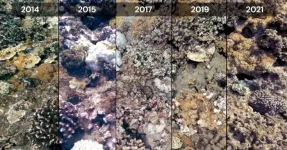(Press-News.org) In a new study, marine biologists from Scripps Institution of Oceanography at UC San Diego and Arizona State University are providing a first-of-its-kind glimpse into coral “bleaching” responses to stress, using imaging technology to pinpoint coral survival rates following multiple bleaching events off the island of Maui. Their findings were published July 31 in the journal PLOS ONE.
Using a time series of coral reef 3D models from Maui, a team of researchers led by Scripps Oceanography’s Smith Lab tracked the bleaching response of 1,832 coral colonies from 2014 to 2021. The seven-year data set provided detailed imagery of the reefs year-by-year, allowing the team to identify patterns of coral growth and survivorship through sequential bleaching events that occurred in 2015 and 2019.
The researchers aimed to distinguish between two different processes: natural selection, where only the hardiest corals in a population survive, and acclimatization, where an individual coral becomes more heat tolerant over time as it is exposed to heat stress.
While some corals bleached and died during the study, the corals that survived both bleaching events showed hopeful signs of resilience. Among these survivors, the researchers found little evidence that bleaching impacted coral growth over time. This unexpected finding has the potential to inform approaches to coral reef conservation and restoration.
“This is one of the first studies to use this type of time series to look at multiple coral bleaching events and how the processes of acclimatization and selection play out,” said lead author Orion McCarthy, a recent graduate of Scripps Oceanography who conducted the research as a PhD student. “We found that older corals, which are more likely to have survived multiple bleaching events, could be a good source of outplants for coral restoration.”
As the oceans warm due to climate change, coral reefs are threatened by bleaching events. These prolonged warming events stress corals and may ultimately lead to their deaths, yet some corals have managed to survive. Researchers around the globe are trying to understand what makes certain corals more resilient than others in an effort that can inform coral restoration projects.
During prolonged ocean warming events, stressed corals expel beneficial algae that live inside their tissue. This causes corals to turn white and “bleach.” Bleaching doesn't cause corals to immediately die, but it does deprive them of their main source of food. If water temperatures remain elevated for too long, bleaching can cause widespread coral mortality. However, low- to moderate-strength bleaching events are most likely to leave behind some surviving coral colonies. These survivors reshape the makeup of the reef and its response to future bleaching events.
The two bleaching events measured in this study were both moderate-strength, with a sustained increase in sea-surface temperatures of more than 1 degree Celsius (1.8 degrees Fahrenheit) for several months. Despite facing similar heat stress in 2015 and 2019, corals did not always respond in the same way. Some corals bleached and died after the first event, some didn’t bleach in either event, some bleached both times but still survived, and some that bleached the first time didn't bleach the second time. Moreover, hardy survivors were often located right next to more sensitive corals that perished, even though both were the same species and experienced the same environmental conditions.
Several species of coral showed signs of acclimatization to bleaching, notably Porites lobata. Populations of Pocillopora corals fared the worst, with the lowest levels of survivorship.
“Based on our observations, we recommend that restoration practitioners in Hawaii should focus on colonies of Porites and Montipora with a proven track-record of growth and survival,” said McCarthy, who now works as a science lead for Sustainable Surf, a nonprofit organization that supports restoration projects focused on coral reefs and other marine ecosystems.
The researchers credited innovative 3D technology with enabling them to detect signs of acclimatization and selection that would have been difficult to track and quantify using traditional in-water surveys. The time series was launched in 2014 by Scripps Oceanography marine biologist Jennifer Smith, a co-author on the study, and her former PhD student Emily Kelly, who now works at the World Economic Forum.
For the past decade, Smith and other members of her lab, including McCarthy, have used large-area imaging, or photogrammetry, to capture a 3D snapshot of coral reefs at fixed sites off Maui. The scuba diving scientists use specialized underwater cameras to capture thousands of overlapping images of the reef, repeating this process year after year. In the lab, these images are processed using advanced software that seamlessly stitches together thousands of 2D pictures into a detailed 3D model of the underwater landscape. Their work in Maui is part of a broader coral reef monitoring initiative called the 100 Island Challenge, which aims to describe global patterns of coral reef change over time using large-area imagery.
“This approach has revolutionized our ability to study long-term changes in coral reef communities at very fine scales,” said Smith, a professor of marine biology at Scripps Oceanography. “We can literally watch these systems change in 3D; we can watch corals grow and shrink and visualize how they respond to global stressors. We can use the knowledge gained from using this approach for education and outreach and our results can help to inform management and conservation action.”
McCarthy compared the process of tracking coral fates through multiple bleaching events to studying human health outcomes following numerous pandemic-like events. By following the responses of individuals during a single event — for example, the COVID-19 pandemic — researchers can infer whether certain traits or qualities are aligned with better or worse health outcomes. If a second pandemic event occurred a short time later, researchers could then look at those data to better understand who survived the first event, and how those survivors fared during the second event. The same logic holds true for corals and bleaching events.
The authors noted that efforts to address climate change — the primary driver of ocean warming — are crucial for securing better outcomes for coral reefs. Severe bleaching events have the potential to cause widespread coral mortality, highlighting the urgency to prevent such dire outcomes through global action to address climate change.
“Coral reefs are dynamic and bleaching isn't necessarily going to kill every coral — at least not in the short term — so there is still cause for hope for these reefs and a need for active conservation,” said McCarthy. “Tools like 3D modeling are allowing us to get a more specific understanding of which corals are living and which ones aren't, and we can use that information to help guide coral restoration efforts.”
In addition to McCarthy and Smith, the study was co-authored by PhD student Morgan Winston from the University of Arizona.
McCarthy’s graduate research at Scripps Oceanography was supported by the National Science Foundation’s Graduate Research Fellowship Program award, though funding was generalized and not awarded for this study specifically.
END
3D models provide unprecedented look at corals’ response to bleaching events
Seven-year time series pinpoints which corals off Maui survived multiple bleaching events
2024-07-31
ELSE PRESS RELEASES FROM THIS DATE:
Study finds White Western women have lower body appreciation and greater media pressure to look thin
2024-07-31
White Western women have lower body appreciation and experience greater pressure from the media to be thin compared to Black Nigerian and Chinese women across all ages, according to new research.
The study, carried out by psychologists at Durham University (UK), and published in PLOS ONE, explored the impacts of age and sociocultural pressures on body appreciation (feelings of positivity and pride about one’s body) amongst White Western, Black Nigerian and Chinese women.
Whilst all three groups had relatively stable body appreciation across ages, there were significant cultural differences.
White ...
Underwater mapping reveals new insights into melting of Antarctica's ice shelves
2024-07-31
Clues to future sea level rise have been revealed by the first detailed maps of the underside of a floating ice shelf in Antarctica.
An international research team - including scientists from the University of East Anglia (UEA) - deployed an unmanned submersible beneath the Dotson Ice Shelf in West Antarctica.
The underwater vehicle, ‘Ran’, was programmed to dive into the cavity of the 350metre-thick ice shelf and scan the ice above it with an advanced sonar. Over 27 days, the submarine travelled more than 1000 kilometres back and forth under the shelf, reaching 17 kilometres into the cavity.
An ice shelf is a mass of glacial ice, fed from land by tributary glaciers, that ...
AI creates cardiology reports for patients
2024-07-31
An artificial intelligence program created explanations of heart test results that were in most cases accurate, relevant, and easy to understand by patients, a new study finds.
The study addressed the echocardiogram (echo), which uses sound waves to create pictures of blood flowing through the heart’s chambers and valves. Echo reports include machine-generated numerical measures of function, as well as comments from the interpreting cardiologist on the heart’s size, the pressure in its vessels, and tissue thickness, which can signal the presence of disease. In the form typically generated by doctors, the reports are difficult for ...
Nasal COVID-19 vaccine halts transmission
2024-07-31
The lightning-fast development of COVID-19 vaccines just months after the virus appeared was a triumph of modern science and saved millions of lives. But for all the good they did in reducing illnesses and deaths, the shots were unable to end the pandemic because of one notable weakness: They couldn’t stop the spread of the virus.
A new study by researchers at Washington University School of Medicine in St. Louis indicates that next-generation vaccines that target the virus’s points of entry — the nose and mouth — may be able to do what traditional shots cannot: contain the spread of respiratory infections and prevent transmission. ...
Downwind states face disproportionate burden of air pollution
2024-07-31
A recent Supreme Court decision to block a federal rule curbing interstate air pollution further complicates efforts to reduce emissions and adds to an already disproportionate burden on “downwind” states, according to researchers at the University of Notre Dame.
“Toxic air pollution is really not as well known by the general public as you would hope, given its impact on human health,” said Paola Crippa, assistant professor in the Department of Civil and Environmental Engineering and Earth Sciences. ...
Barriers designed to prevent saltwater intrusion may worsen inland flooding
2024-07-31
As Earth continues to warm, sea levels have risen at an accelerating rate – from 1.4 millimeters a year to 3.6 millimeters a year between 2000 and 2015. Flooding will inevitably worsen, particularly in low-lying coastal regions, where more than a billion people are estimated to live. Solutions are needed to protect homes, property and groundwater from flooding and the intrusion of saltwater.
Seawalls and similar infrastructure are obvious options to protect against flooding. In fact, cities such as New York and San Franciso have already thrashed out potential plans with the Army Corps of Engineers that will heavily rely ...
Vaping and smoking together increases lung cancer risk fourfold
2024-07-31
COLUMBUS, Ohio – People who both vape and smoke are four times more likely to develop lung cancer than people who just smoke, according to new study published by The Ohio State University Comprehensive Cancer Center – Arthur G. James Cancer Hospital and Richard J. Solove Research Institute (OSUCCC – James) and College of Public Health. These findings were consistent across gender and race.
This is the first study to provide evidence that smoking in combination with vaping increases the risk for cancer compared to smoking alone. Researchers ...
Scientists discover unexpected behavior in dimers of CO₂ molecules after ionization
2024-07-31
A team of international scientists has unveiled a surprising discovery in molecular physics, revealing unexpected symmetry-breaking dynamics in ionized carbon dioxide dimers. Published in Nature Communications, the study provides new insights into the structural changes that occur when these molecular clusters are exposed to extreme ultraviolet (EUV) radiation.
An international team of scientists, led by Profs. Daniel Strasser and Roi Baer from The Hebrew University of Jerusalem, has made an important discovery in molecular physics, revealing unexpected symmetry-breaking dynamics in ionized carbon dioxide dimers. Published in Nature Communications, ...
Cracking the carb code: Researchers create new glycemic index database to improve dietary awareness
2024-07-31
Karen Della Corte, BYU nutrition and dietetics professor, recently authored a new study, published in The American Journal of Clinical Nutrition, that developed a national glycemic index (GI) and glycemic load (GL) database to offer insights into the evolving quality of carbohydrates consumed in the United States, something that hadn’t been done previously.
The GI is a scale used by public health researchers to categorize the quality of the carbohydrates. High-GI foods like white flour and sugar cereals cause a “sugar rush” that can negatively impact metabolic health. ...
Military health research reveals potential pathway to reducing youth suicide
2024-07-31
Military-connected youth that show elevated risk for suicidal ideation and suicide plans exhibit lower rates of gun-carrying, according to new research from emergency medicine faculty at the University of Colorado School of Medicine.
The analysis, published in JAMA Network Open July 31 by members of the CU Center for Combat Medicine and Battlefield (COMBAT) Researchand Firearm Injury Prevention Initiative (FIPI), offers promising insight for potentially reducing gun-carrying among youths with recent suicidal ideation or plans. Researchers are also interested in how relevant strategies in military communities ...
LAST 30 PRESS RELEASES:
Longest observation of an active solar region
Why nail-biting, procrastination and other self-sabotaging behaviors are rooted in survival instincts
Regional variations in mechanical properties of porcine leptomeninges
Artificial empathy in therapy and healthcare: advancements in interpersonal interaction technologies
Why some brains switch gears more efficiently than others
UVA’s Jundong Li wins ICDM’S 2025 Tao Li Award for data mining, machine learning
UVA’s low-power, high-performance computer power player Mircea Stan earns National Academy of Inventors fellowship
Not playing by the rules: USU researcher explores filamentous algae dynamics in rivers
Do our body clocks influence our risk of dementia?
Anthropologists offer new evidence of bipedalism in long-debated fossil discovery
Safer receipt paper from wood
Dosage-sensitive genes suggest no whole-genome duplications in ancestral angiosperm
First ancient human herpesvirus genomes document their deep history with humans
Why Some Bacteria Survive Antibiotics and How to Stop Them - New study reveals that bacteria can survive antibiotic treatment through two fundamentally different “shutdown modes”
UCLA study links scar healing to dangerous placenta condition
CHANGE-seq-BE finds off-target changes in the genome from base editors
The Journal of Nuclear Medicine Ahead-of-Print Tip Sheet: January 2, 2026
Delayed or absent first dose of measles, mumps, and rubella vaccination
Trends in US preterm birth rates by household income and race and ethnicity
Study identifies potential biomarker linked to progression and brain inflammation in multiple sclerosis
Many mothers in Norway do not show up for postnatal check-ups
Researchers want to find out why quick clay is so unstable
Superradiant spins show teamwork at the quantum scale
Cleveland Clinic Research links tumor bacteria to immunotherapy resistance in head and neck cancer
First Editorial of 2026: Resisting AI slop
Joint ground- and space-based observations reveal Saturn-mass rogue planet
Inheritable genetic variant offers protection against blood cancer risk and progression
Pigs settled Pacific islands alongside early human voyagers
A Coral reef’s daily pulse reshapes microbes in surrounding waters
EAST Tokamak experiments exceed plasma density limit, offering new approach to fusion ignition
[Press-News.org] 3D models provide unprecedented look at corals’ response to bleaching eventsSeven-year time series pinpoints which corals off Maui survived multiple bleaching events



